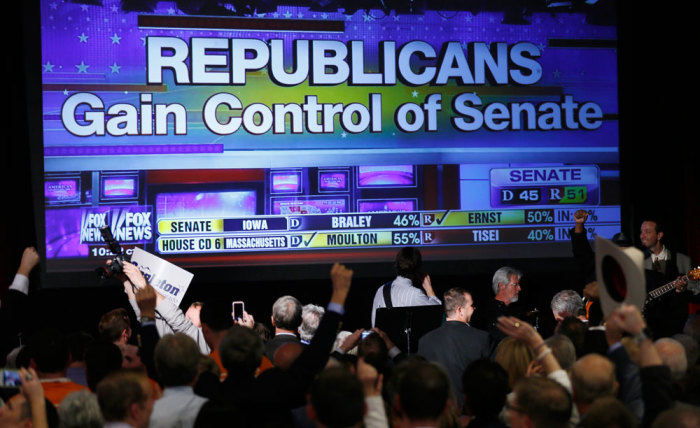Analysis: Republicans Won by Doing Better Among Non-Whites, Less Religious, Unmarried, Young

Some pundits have described the 2014 midterms as a base-turnout election, arguing that Republicans did a better job than Democrats turning out their base voters. The exit polls do not support this view, however.
The Republican base turned out at about the same rate as in 2012. Republicans won most their races on Tuesday by expanding its base with demographic groups that voted Democrat in 2012.
Race and Ethnicity
Whites were about the same portion of the electorate and voted Republican at about the same rate as they did in 2012. They were 72 percent of the electorate and 59 percent of them voted Republican in 2012; in 2014 they were 75 percent of the electorate and 60 percent voted Republican.
Among non-whites, on the other hand, Republicans saw significant gains since 2012. They gained three percentage points among blacks, nine percentage points among Latinos, and 24 percentage points among Asians, who gave half of their votes to Republicans.
(All analyses used CNN exit polls for presidential vote choice in 2012 and House vote choice in 2014. To ensure accuracy, comparisons were made with other exit polls.)
Religion
The Republican base of white Evangelicals, white Catholics and those who attend religious services often turned out at about the same rate and voted Republican at about the same rate as they did in 2012.
This year, white Evangelicals were 26 percent of the electorate and 78 percent of them voted Republican, which is exactly the same as in 2014. Similarly, white Catholics voting patterns remained the same as in 2012 (19 percent of the electorate with 60 percent voting Republican).
Similarly, those who attend religious services weekly or more turned out at about the same rate and voted Republican at about the same rate as they did in 2012. And, those who never attend religious services turned out at about the same rate and voted Democrat at about the same rate as they did in 2012.
This big difference for Republicans this year is how they did among the slightly religious. Those who said they attend religious services monthly or a few times a year (40 percent of the electorate in both years) favored Democrats in 2012 (55 percent) and favored Republicans in 2014 (52 percent).
Marriage and Gender
While the media often talks about the "gender gap" (Republicans have more support among men and Democrats have more support among women), a larger partisan difference can be found in the "marriage gap" (Republicans have more support from those who are married and Democrats have more support from those who are single).
The Republican base of married voters did not change much. In 2012, married voters were 60 percent of the electorate and 56 percent of them voted Republican. In 2014, married voters were 63 percent of the electorate and 58 percent of them voted Republican. Among unmarried voters, on the other hand, Republicans gained seven percentage points, from 35 to 42 percent.
Combining marriage with gender, Republicans gained eight percentage points among unmarried men (40 to 48 percent), and seven percentage points among unmarried women (31 to 38 percent).
Age
The one area where a case could be made that base turnout made a difference is among young voters, but even here the effect was small. The bigger problem for Democrats was not that young voters did not show up, but that they did not vote Democrat at a high enough rate. Republicans gained six percentage points among young (18 to 29-year-old) voters, from 37 percent in 2012 to 43 percent in 2014.
The drop in young voter participation rate was six percentage points, from 19 to 13 percent of the electorate. But much of that drop was among the young white voters (from 11 to eight percent of the electorate), who favored Republicans in 2012 (51 percent) and in 2014 (54 percent).
Among young blacks, whose share of the electorate went from three to two percent, Republicans gained three percentage points (eight to 11 percent). And among young Latinos, whose share of the electorate went from four to two percent, Republicans gained five percentage points (23 to 28 percent).





























